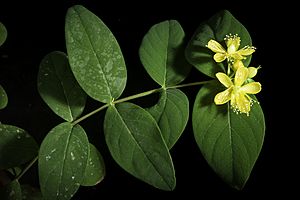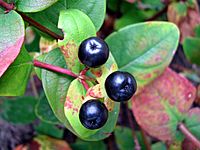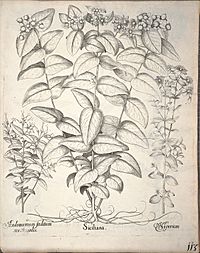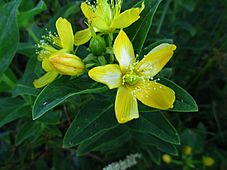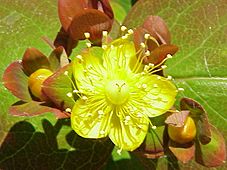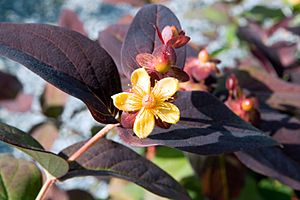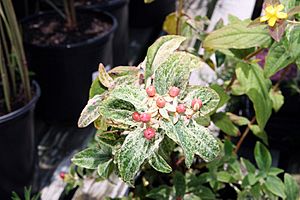Shrubby St facts for kids
Quick facts for kids Shrubby St |
|
|---|---|
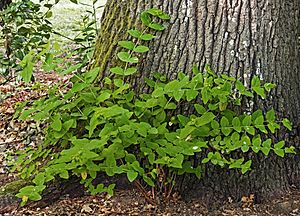 |
|
| Habit | |
| Scientific classification | |
| Genus: |
Hypericum
|
| Species: |
androsaemum
|
| Synonyms | |
|
|
Hypericum androsaemum, also known as the shrubby St. John's wort, is a flowering plant in the family Hypericaceae. People often call it tutsan or sweet-amber. This plant is grown as an ornamental plant because it has beautiful red-tinted leaves, bright yellow flowers, and large groups of berries. Some special types, like 'Albury Purple' and 'Golden Tutsan', have even more colorful leaves.
This plant originally comes from Western Europe, North Africa, and the Middle East. But it has also been brought to other places with lots of rain, like Australia and New Zealand. In these countries, it can sometimes grow too much and become a noxious weed. The plant spreads easily because its seeds are small and there are many of them. Scientists are looking for ways to control it using biological control.
People knew about this plant even before we had our modern way of naming plants. Carl Linnaeus first described it in 1763. Over time, it was sometimes put into its own group called Androsaemum. But in 1996, a botanist named Norman Robson officially placed it back into the Hypericum group, specifically in a small section called Hypericum sect. Androsaemum. This section includes a few other plants that are very similar.
Contents
What Does Tutsan Look Like?
The tutsan plant is a small, bushy shrub that usually grows to be about 30 to 70 centimeters (1 to 2.3 feet) tall. It has many stems that stand straight up. Its leaves are oval-shaped and often green with a reddish tint. If you look closely, you might see tiny glands on the leaves that are filled with red color.
The plant has yellow flowers that are about 1.5 to 2.5 cm (0.6 to 1 inch) wide. Each flower has five petals and many stamens. What makes tutsan special is its berries. They change from red to black and stay soft and juicy even after they are ripe. The stems of older plants are round and have grooves or scale-like patterns on their bark.
Leaves and Flowers
The leaves grow in pairs on opposite sides of the stem. They don't have small leaf-like parts called stipules or stalks called petioles. Each leaf is about 4 to 12 cm (1.6 to 4.7 inches) long and 2 to 8 cm (0.8 to 3.1 inches) wide. The leaves are smooth and have tiny oil glands on their surface. When these glands are crushed, they release a strong smell and a red liquid.
The tutsan plant usually has between one and eleven flowers grouped together. These flower clusters are called inflorescences. The flower stalks are 8 to 14 mm long and have small, pointed bracts.
The flowers themselves are 15 to 25 mm (0.6 to 1 inch) wide and have round buds. The green parts at the base of the flower, called sepals, are different sizes. The yellow petals are bright and curve inward. The stamens are grouped into five bundles, with 20 to 25 stamens in each. The longest stamens are 7 to 11 mm long. The ovaries are roughly globe-shaped.
The berries of the tutsan plant turn a unique black color when they are ripe. This black color is not found in other Hypericum species. Another special thing about these berries is that they stay soft and fleshy when ripe, unlike other related plants whose berries become hard and dry. The berries are 7 to 12 mm long and 6 to 8 mm wide, with thin skins. The seeds inside are reddish-brown.
Plant Names and History
The name Hypericum comes from ancient Greek words: hyper meaning "above" and eikon meaning "picture." This refers to an old custom of hanging the flowers "above pictures" to keep away bad spirits. The second part of the name, androsaemum, also comes from Greek. It means "man's blood" and describes plants with red sap. The common name tutsan comes from a French phrase, tout-saine, which means "heal-all," because people used the plant for medicine. Its other name, sweet-amber, refers to the amber-like smell that comes from the oil glands on its leaves when they are crushed.
How We Name Plants
Hypericum androsaemum is the main example for a small group of plants called Hypericum sect. Androsaemum. This is how it fits into the larger plant family:
- Hypericum subg. Hypericum
- Hypericum sect. Androsaemum
- H. androsaeumum
- H. foliosum
- H. grandifolium
- H. hircinum
- H. × inodorum
- Hypericum sect. Androsaemum
A Look Back in Time
People knew about Hypericum androsaemum a long time ago, even before our modern system of naming plants was created. For example, it was shown in a famous book of plant drawings called Hortus Eystettensis in 1640.
Carl Linnaeus was the first to officially describe the plant using the modern system in 1763. He called it Hypericum androsaemum in his book Species Plantarum. Linnaeus noted that the plant grew in England, often near fences. Even though Linnaeus's original plant sample wasn't saved, a botanist named Norman Robson later chose a drawing from another book, Hortus Cliffortianus, to represent the species. This helped make sure everyone agreed on what Hypericum androsaemum was.
Different Types of Tutsan
The tutsan plant can look a bit different depending on where it grows or how it's bred. When people purposely grow plants with special features, these are called "cultivars." For example, there's a type called H. androsaemum var. aureum which has yellow-green leaves, and another called H. androsaemum f. variegatum which has leaves with different colored patches.
In the wild, tutsan plants also show a variety of traits. Some have larger flowers, redder leaves, and bigger fruits, while others have smaller flowers, greener leaves, and smaller fruits. These differences are natural and connect smoothly, so they don't get special names.
Plants That Look Alike
Hypericum androsaemum looks similar to other plants in its group, section Androsaemum. You can tell it apart from H. foliosum and H. × inodorum because its ripe berries are uniquely black. Also, its petals are never longer than its sepals.
It also looks a lot like Hypericum xylosteifolium. The main way to tell them apart is by their berries. H. xylosteifoliums berries dry out completely when they are ripe, but H. androsaemums berries stay soft and fleshy. Tutsan berries only dry out if they are left on the plant for about a month after ripening.
- Comparing flowers of related species
Where Tutsan Grows
The tutsan plant likes damp and shady places. It can grow at many different heights, from low areas up to 1,800 meters (5,900 feet) high. It needs a lot of rain, usually more than 750 mm (30 inches) of rain each year.
Native and Introduced Areas
This plant naturally grows in many places, but it's most common in Western Europe. You can find a lot of it in the British Isles, the Ardennes forest in Belgium and France, and along the western French coast. It also grows in the Pyrenees Mountains, northern Spain, Portugal, and parts of central Italy. Some scattered plants have been seen in Germany, Denmark, Switzerland, Austria, and the Balkans. Outside of Europe, H. androsaemum is found in northern Turkey, the North African coast, the Caucasus, and Iran. It used to grow on the island of Corsica, but it's thought to be gone from there now.
Hypericum androsaemum has also started growing in places where it's not native. In Australia, it's common in areas like the Otway Ranges and the Blue Mountains. In New Zealand, it's found on both islands and is considered a spreading weed.
How It Spreads and Becomes Invasive
In the late 1800s, H. androsaemum was a popular ornamental plant. This led to it being spread widely to new regions. Even though its seeds don't have special features to help them fly far, they are small and very numerous. This means they can easily get stuck in cargo, on animals, clothing, or vehicles, and be carried to new places. It was brought to Australia in 1865 for its pretty red leaves and yellow flowers. In New Zealand, birds are thought to be the main way its seeds spread.
Because it can become an invasive weed, scientists have looked into ways to control it. In 2008, Landcare Research started studying if certain insects could help. They found that a moth called Lathronympha strigana and a beetle called Chrysolina abchasica eat only this plant and wouldn't harm other native plants. As of 2017, some moths have been released in New Zealand to help control the plant.
Life Cycle and Growing Tutsan
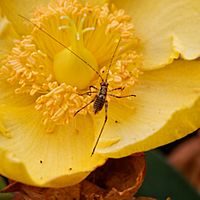
The seeds of Hypericum androsaemum usually sprout in the fall. The plant starts to flower when it is about 18 to 24 months old, usually from late spring to early summer. Its fruit then ripens by late summer. The plant loses most of its leaves in the fall, but new ones grow quickly every spring.
How to Grow Tutsan
When you grow Hypericum androsaemum in a garden, it doesn't need much care. It usually doesn't get many pests or diseases and deer tend to avoid it. However, it can sometimes get tiny worms called nematodes that cause root rot. Other small insects like thrips and scale have also been seen. In hot and humid places, the plant might wilt or get root rot. It can grow in slightly acidic or alkaline soils and can handle dry spells and cold temperatures down to -20° C (-4° F).
For the best growth, plants should be spaced about 90 cm (3 feet) apart. If you let it, the plant will drop its own seeds and grow new plants, creating a ground cover. After the leaves fall in autumn, you can cut the plant back, and it will grow new shoots from the base in the spring.
Most Hypericum seeds are hard to sprout because they are "asleep" (dormant). Tutsan seeds are also dormant, meaning they need special conditions to wake up. Soaking them in room-temperature water or using a plant hormone called gibberellic acid can help them sprout.
To grow new plants from seeds, you can sow non-dormant seeds in a greenhouse at 10°C (50°F) in the spring, with a very thin layer of soil on top. After 1 to 3 months, when the young plants are big enough, you can move them into their own pots. Once the last frost of winter has passed, the new plants can be moved outside to their permanent spots. Another way to grow new plants is by taking cuttings (small pieces of stem) in the fall. These cuttings are kept in a frame over fall and winter, then planted in the spring.
Special Types (Cultivars)
To help stop Hypericum androsaemum from spreading too much in places where it's not native, scientists have created special types called "triploid clones." These plants have extra sets of chromosomes, which makes them produce much less pollen and no seeds at all. This means they can't spread easily, but they still grow the large, colorful berries that people like.
| Name | Creator | What it looks like | Notes |
|---|---|---|---|
| 'Albury Purple' | Leaves are purple, fruit is redder | Also called 'Tedbury Purple' | |
| 'Glacier' | Leaves are mostly white with some green | ||
| 'Golden Tutsan' | Leaves are golden yellow | ||
| 'Matisse' | North Carolina State University | Leaves have green and white spots | Triploid (doesn't spread seeds) |
| 'Picasso' | North Carolina State University | Leaves have a purple tint | Triploid (doesn't spread seeds) |
| 'Pollock' | North Carolina State University | Leaves have abstract color patterns | Triploid (doesn't spread seeds) |
Uses of Tutsan
Like many other Hypericum plants, H. androsaemum has been used as a medicinal plant in folk medicine for a long time. For example, people used it to help the body get rid of extra water (as a diuretic), to treat nerve pain like sciatica and gout, and to stop bleeding and help burns and small wounds heal faster.
Unlike some other Hypericum species, tutsan doesn't have a chemical called hypericin, which can sometimes irritate skin. This makes H. androsaemum safer for use on the skin and in skincare products. It has also been tested as an antidepressant and seems to work as well as other similar plants. In Portugal, people use its leaves to treat problems with the liver, kidneys, and bladder. In England, the leaves are mixed with lard to make an ointment for cuts and wounds. Lab tests have shown that the berries of Hypericum androsaemum have properties that protect cells from damage, which supports their use in teas for liver health or as diuretics.
Images for kids
See also
 In Spanish: Hypericum androsaemum para niños
In Spanish: Hypericum androsaemum para niños


